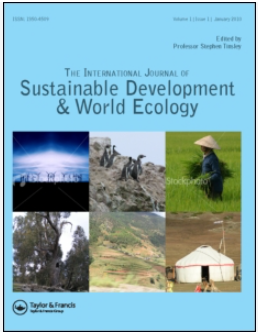基于2030年可持续发展议程的中国生态环境可持续发展进展与空间格局评估
IF 7.7
3区 环境科学与生态学
Q1 ECOLOGY
International Journal of Sustainable Development and World Ecology
Pub Date : 2022-12-18
DOI:10.1080/13504509.2022.2155265
引用次数: 0
摘要
生态环境是人类赖以生存和发展的基础。为了深入了解中国生态环境面临的挑战,对可持续生态环境发展(SED)进行科学、量化的评估是必不可少的,可以指导政策的制定和实施。然而,基于2030年可持续发展目标议程(SDGs),缺乏评估实现战略经济对话进展的系统方法。因此,我们开发了一种系统的方法来量化中国省级SED的进展。在建议的方法中,SED指标框架与全球指标框架(GIF)保持一致,对每个指标采用明确的统计定义,并在中国省级层面采用数据选择标准。提出了一种识别指标值上下限的四级方法,将指标值归一化为0-100的标准刻度。将SED指数和三个综合指数通过个体得分的算术平均数进行汇总,以评估SED的总体进展。采用空间自相关分析探讨SED指数得分的空间格局。结果表明,除山东和河北外,其余省份在实现SED方面表现较好。大部分省份的水域生态环境优于空气和陆地生态环境。此外,部分省份SED指数得分呈现正空间自相关格局,高值(低值)集聚区主要集中在西(东)区。这些结果使我们对中国各省战略经济发展面临的挑战有了更深入的了解。本文章由计算机程序翻译,如有差异,请以英文原文为准。
Assessing the progress and spatial patterns of sustainable eco-environmental development based on the 2030 Agenda for SDGs in China
ABSTRACT The eco-environment is fundamental for human survival and development. To gain insight into Chinese eco-environmental challenges, a scientific and quantifying assessment of sustainable eco-environmental development (SED) is essential and can guide policy development and implementation. However, systematic methods for assessing progress towards achieving SED are lacking based on the 2030 Agenda for the Sustainable Development Goals (SDGs). Therefore, we developed a systematic method to quantify SED progress at the provincial level in China. In the proposed method, the SED indicator framework was developed to align with the global indicator framework (GIF), adopting clear statistical definitions for each indicator and the criteria of data selection at provincial levels in China. A four-level method of identifying the upper and lower bounds of the indicator values was proposed to normalise them to a standard scale of 0–100. The SED index and three composite indices were aggregated by the arithmetic means of the individual scores for assessing overall SED progress. A spatial autocorrelation analysis was used to explore the spatial patterns of the SED index scores. The results showed that all provinces except Shandong and Hebei had relatively good performances in achieving SED. Most provinces performed better in terms of the water area eco-environment than they do in terms of the air and terrestrial eco-environments. In addition, some provinces showed a positive spatial autocorrelation pattern on the SED index scores, and the high-value (low-value) aggregation regions were mainly concentrated in Western (East) China. These results provide a richer understanding of the challenges for SED faced by each province in China.
求助全文
通过发布文献求助,成功后即可免费获取论文全文。
去求助
来源期刊
CiteScore
11.10
自引率
3.60%
发文量
58
审稿时长
18-36 weeks
期刊介绍:
The International Journal of Sustainable Development and World Ecology is now over fifteen years old and has proved to be an exciting forum for understanding and advancing our knowledge and implementation of sustainable development.
Sustainable development is now of primary importance as the key to future use and management of finite world resources. It recognises the need for development opportunities while maintaining a balance between these and the environment. As stated by the UN Bruntland Commission in 1987, sustainable development should "meet the needs of the present generation without compromising the ability of future generations to meet their own needs."

 求助内容:
求助内容: 应助结果提醒方式:
应助结果提醒方式:


